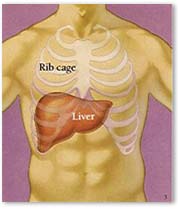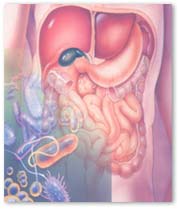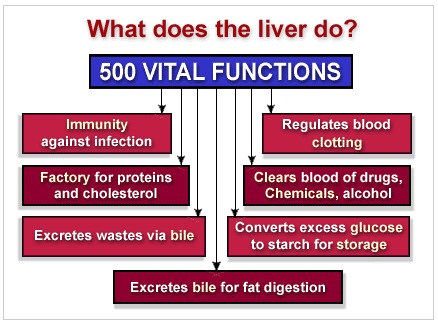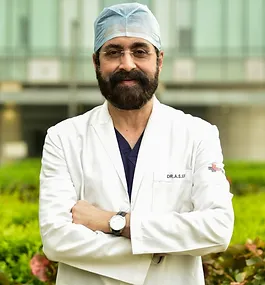About Your Liver
Liver Information : About the Liver
October 20, 2024
Where is it and what does it look like?
- Oxygenated blood flows in from the hepatic artery
- Nutrient-rich blood flows in from the hepatic portal vein
Table of Contents
Toggle

The liver holds about 500 ml (13 percent) of the body’s blood supply at any given moment.
The liver consists of two main lobes – the right and the left, both of which are made up of thousands of lobules. These lobules are connected to small ducts that connect with larger ducts to ultimately form the hepatic duct. The hepatic duct transports the bile produced by the liver cells to the gallbladder and duodenum (the first part of the small intestine).
What does the liver do?
The liver regulates most chemical levels in the blood and excretes a product called “bile,” which helps carry away waste products from the liver. All the blood leaving the stomach and intestines passes through the liver. The liver processes this blood and breaks down the nutrients and drugs into forms that are easier to use for the rest of the body.

The liver is the most complex and metabolically active organ in the body. It performs more than 500 vital functions. Some of the important ones are
- It provides immunity against infection. Hence if the liver is damaged, infections are more likely.
- It is the factory for manufacturing most of the important proteins in the body, and also cholesterol and special fat forms called lipoproteins in which all body fats are carried.
- It clears the blood of most chemicals, drugs and alcohol.
- It excretes bile into the intestine. Bile is vital for digestion of fats, and also serves to throw out body wastes.
- It regulates clotting of blood by manufacturing vital proteins
- It converts and stores extra sugar (glucose) in the form of starch (glycogen) which can be used in times of starvation.
What makes the liver unique?
RESERVE
All liver functions remain normal even if 70% of it is removed (provided the remaining 30% is healthy). Hence, in persons with cancer of the liver, large portions of cancerous liver can be removed without causing harm or compromise to liver function. Similarly, more than half the liver can be removed from the donor for transplantation purposes, without causing any derangement of liver function or any other serious harm to the donor.
REGENERATION
The liver is the only organ in the body which can regenerate itself after large portions of it are removed. Small remnants of liver grow back to normal size within a few weeks. This is another reason why it is safe to remove large portions of liver from living donors and persons with liver tumours.
This is also why half livers transplanted into liver failure patients are very successful since they soon grow to normal size.
FAQs
What is the main function of the liver?
The liver is one of the body’s most vital organs, responsible for over 500 crucial functions to maintain internal balance. Key roles include detoxifying the blood, producing bile to aid digestion, and regulating glucose storage and release. It plays an essential part in metabolizing fats, proteins, and carbohydrates, ensuring the body efficiently absorbs and processes nutrients. The liver also stores important vitamins and minerals, such as iron and vitamin A, and synthesizes proteins required for blood clotting. Without the liver’s detoxification and metabolic processes, the body would accumulate harmful toxins, leading to potential organ failure.
What are common signs of liver disease?
Liver disease symptoms can start subtly but become more pronounced as the condition worsens. Early symptoms may include fatigue, nausea, and loss of appetite. As the disease progresses, more specific signs such as jaundice (yellowing of the skin and eyes), dark urine, pale stools, and itching skin may appear. Other symptoms include easy bruising, swelling in the abdomen, and unexplained weight loss. Because many symptoms don’t appear until significant liver damage has occurred, early diagnosis is key to preventing further deterioration.
How can I keep my liver healthy?
Maintaining liver health requires a balanced lifestyle. Since excessive alcohol consumption is a leading cause of liver disease, limiting or avoiding alcohol is crucial. Eating a nutritious diet low in refined sugars and saturated fats, alongside regular exercise, helps prevent obesity, a risk factor for non-alcoholic fatty liver disease (NAFLD). Keeping up-to-date on hepatitis vaccinations and practicing good hygiene can prevent viral infections like hepatitis A and B. Additionally, avoiding unnecessary medications and harmful supplements can reduce undue stress on the liver.
What are the causes of liver failure?
Liver failure occurs when the liver becomes so damaged that it can no longer perform its essential functions. Common causes include chronic viral infections, such as hepatitis B and C, and long-term alcohol abuse, which can lead to cirrhosis. Non-alcoholic fatty liver disease (NAFLD), often associated
with obesity and diabetes, is another major cause. Acute liver failure can also result from exposure to toxins, infections, or an overdose of certain medications, such as acetaminophen.
Can liver disease be cured?
The possibility of curing liver disease depends on the stage and underlying cause. In the early stages, conditions like fatty liver disease can often be reversed with lifestyle changes, such as improved diet and regular exercise. Hepatitis B and C, once major causes of liver damage, can now be managed or cured in many cases with antiviral medications. However, advanced liver diseases like cirrhosis often cause irreversible damage. In such cases, treatment focuses on slowing the progression of the disease and managing symptoms. In severe cases of liver failure, a liver transplant may be the only option. Early detection and intervention significantly improve the chances of managing or even curing liver disease.


